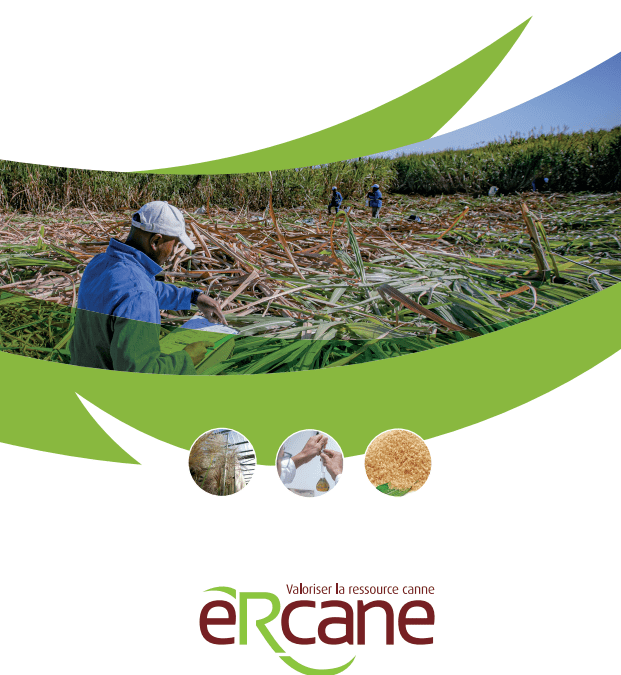🌱 Présentation d’eRcane
Origines et structure
-
Créé en 1929 sous le nom de Station d’essai de La Bretagne, il est devenu le CERF (Centre d’Essai, de Recherche et de Formation) en 1974, puis a pris le nom eRcane en 2009.
-
Il fonctionne aujourd’hui comme un Groupement d’intérêt économique (GIE) détenu à 50 % chacun par les deux sucreries locales : Sucrerie de Bois‑Rouge et Sucrerie de La Réunion
Missions principales
-
Création variétale : création de variétés de canne à sucre à haut rendement, résistantes aux maladies, bien adaptées aux conditions agro‑climatiques de l’île. Le centre gère environ 200 hectares d’essais variétaux répartis sur 7 stations et un centre d’hybridation.
-
Techniques culturales : développement et promotion de méthodes plus durables et agroécologiques (désherbage, fertilisation, plantation, etc). Depuis 2015 le service coordonne l’animation du RITA Canne à La Réunion (Réseau d’Innovation et de Transfert Agricole). Depuis 2024, une nouvelle équipe de techniciens en conseil et transfert vient renforcer le dispositif de parcelles de démonstration du RITA.
-
Procédés et innovations industriels : optimisation du process sucrier, valorisation des coproduits (chimie verte), automatisation industrielle via des systèmes de contrôle‑commande, etc..
🏅 Réalisations et impact
-
Certaines variétés créées par eRcane, comme la R 570 ou la R 579, sont cultivées non seulement à La Réunion mais également dans de nombreux pays producteurs.
-
eRcane collabore étroitement avec le CIRAD et les CTCS de Guadeloupe et Martinique, notamment dans le cadre de projets comme IDECAS, visant à réduire l’usage d’herbicides au travers du plan PARSADA (Ecophyto 2030)
-
L’organisation a contribué à des avancées majeures comme le séquençage complet du génome de la canne à sucre, basé sur la variété R 570, publiées dans la revue Nature en mars 2025.
Plaquette en français : Plaquette Français 2020 pdf
__________________
🌱 About eRcane
Origins ans structure
-
Founded in 1929 under the name La Bretagne expérimental Station, the institute became the CERF (Centre for Testing, Research and Training) in 1974, and was renamed eRcane in 2009.
-
Today, it operates as an Economic Interest Group (EIG) equally owned (50% each) by the island’s two local sugar factories: Bois-Rouge Sugar Mill and La Reunion Sugar Mill.
Main missions
-
Plant Breeding: breeding high-yield, disease-resistant sugarcane varieties well adapted to the island’s agro-climatic conditions. The institute manages around 200 hectares of varietal trials across 7 research stations and a hybridization center.
-
Cropping Techniques: development and promotion of more sustainable and agroecological methods (weeding, fertilization, planting, etc.). Since 2015, the department has coordinated the activities of the RITA Cane Network in La Réunion (Agricultural Innovation and Transfer Network). Since 2024, a new team of technical advisors has been reinforcing the RITA system through demonstration plots.
-
Industrial Processing and Innovation: Procédés et innovations industriels : pptimization of the sugar production process, valorization of by-products (green chemistry), and industrial automation through control-command systems, among other innovations.
🏅 Achievements and Impact
-
Some sugarcane varieties developed by eRcane, such as R570 and R579, are cultivated not only in La Réunion but also in many other sugar-producing countries.
-
eRcane works closely with CIRAD and the CTCS organizations in Guadeloupe and Martinique, particularly through projects like IDECAS, aimed at reducing herbicide use as part of the PARSADA plan (Ecophyto 2030 framework).
-
The institute has contributed to major breakthroughs, including the complete sequencing of the sugarcane genome, based on variety R570, published in the journal Nature in March 2025.
Presentation brochure in english : Brochure English 2022 pdf

